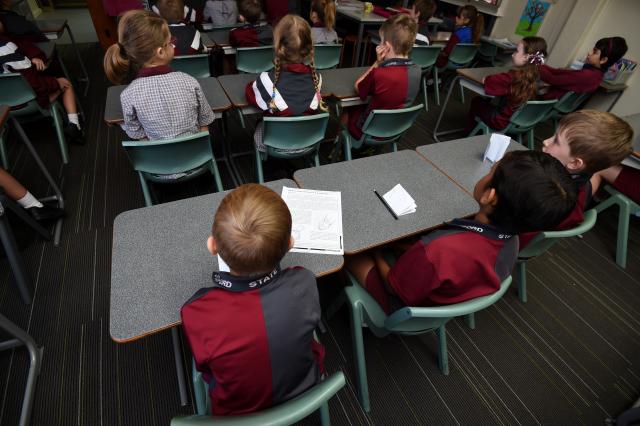Around 10 per cent of students across Australia need additional support in literacy and numeracy to meet higher NAPLAN expectations, according to the latest data released today by the Australian Curriculum, Assessment and Reporting Authority (ACARA) in the new-look 2023 NAPLAN national results.
The latest figures also show that approximately 65 per cent of students across Australia are meeting the higher literacy and numeracy expectations, achieving in the ‘Strong’ and ‘Exceeding’ proficiency levels, while around 23 per cent of students are in the ‘Developing’ level and working towards meeting expectations.
Participation rates nationally have bounced back in 2023, increasing on average by two percentage points across all years and domains, compared to 2022, from 91.4 per cent to 93.3 per cent.
This was “a very good sign” ACARA CEO David de Carvalho said, reversing a downward trend apparent in recent years and exacerbated by the impact of the Covid pandemic.
“This year’s NAPLAN results are the first to reflect the new reporting changes. They show strong performance among Australian students in literacy and numeracy skills, but also provide clear information on areas requiring improvement,” Mr de Carvalho said.
Under the new approach, students are assessed against four levels of proficiency based on previous years of schooling: Exceeding, Strong, Developing and Needs additional support. The new reporting system more clearly and simply shows NAPLAN achievement, identifying where expectations are being met.
“Importantly, with expectations set at a higher level than in previous years, the new reporting is showing those areas where we need to focus our efforts on supporting more students to meet expectations and succeed,” Mr de Carvalho said.
“The results also continue to highlight the educational disparities of students from non-urban areas, Indigenous Australian heritage and those with low socio-educational backgrounds.”
Key highlights from this year’s NAPLAN national results include:
• Across year level groups on average, 65 per cent of students in Year 3, 68 per cent in Year 5, 67 per cent in Year 7 and 62 per cent in Year 9 met the higher expectations (were in the ‘Exceeding’ and ‘Strong’ levels) for literacy and numeracy.
• In numeracy, on average, the proportion of students who achieved at ‘Exceeding’ and ‘Strong’ levels in 2023 increases from Year 3 (64.7 per cent) to Year 5 (67.7 per cent) and Year 7 (67.2 per cent) and then drops in Year 9 (63.9 per cent), apart from Western Australia (69.4 per cent).
• In writing, primary students were more likely to achieve at ‘Exceeding’ or ‘Strong’ levels than secondary students, with 76.0 per cent of Year 3 students and 66.2 per cent of Year 5 students meeting expectations compared to 62.5 per cent in Year 7 and 58.0 per cent in Year 9.
• Nationally, participation rates have bounced back. For primary years, it increased from 93.8 per cent to 95.1 per cent. For secondary years, it increased from 88.9 per cent to 91.6 per cent.
• Participation rates ranged from 88.4 per cent (Year 9 numeracy) to 95.9 per cent (Year 5 reading).
• Demographic results reflect trends in other national assessments and previous NAPLAN results with girls outperforming boys in literacy, and higher results tending to align with students from the highest socio-educational backgrounds, in urban areas, or from non-Indigenous backgrounds. Specifically:
– Nationally, just under 10 per cent of students (on average across all year levels and domains) are in the ‘Needs additional support’ level while, on average across all year levels and domains, around a third of Indigenous students ‘need additional support’.
– Average NAPLAN scores for all year levels and all domains for students from the highest socio-educational background were substantially above those from the lowest.
– Fewer than three in 10 students (30 per cent) in very remote schools are rated as ‘Strong’ or ‘Exceeding’ in any domain or year level, while at least three in five students (60 per cent) in major city schools are rated ‘Strong’ or ‘Exceeding’ across almost all domains and year levels.
– Girls outperformed boys in writing, achieving average NAPLAN scores above boys in every year group, with higher percentages of girls at ‘Strong’ or ‘Exceeding’ levels, notably 70.0 per cent of girls compared to 55.4 per cent of boys in Year 7 and 66.3 per cent of girls compared to 50.2 per cent of boys in Year 9.
– Boys generally outperformed girls in numeracy. The difference was statistically significant in Year 5, with 6 per cent fewer girls in that year level achieving in the ‘Exceeding’ level compared to boys.
The new approach to NAPLAN reporting also complements the other recent NAPLAN improvements endorsed by education ministers. With online adaptive NAPLAN testing now in place in all schools, a new measurement scale has been developed that means results do not have to be equated back to the paper test results of previous years.
This delivers the full benefit of the more precise data derived from online testing. In combination with shifting the NAPLAN test window to March instead of May, this means that these results cannot be compared to previous years.
Both of these changes were recommended by the independent review of NAPLAN completed in 2020. Restarting the time-series has set a new and better baseline for future comparisons and will provide ministers with valuable insights as they progress their discussions about the next National Schools Reform Agreement.
From next year, results will come to schools much earlier now that improvements introduced for 2023 have been implemented. To access the full 2023 NAPLAN national results, including information about the socio-educational profile of each jurisdiction, please visit: https://www.acara.edu.au/naplanresults.







